 Akragas – Agrigento
Akragas – Agrigento
Around 580 BC, the wealthy colony of Gela in the south of the island began trading their crops to the west, to the Sicani, Elymian and the Carthaginians. The Greek colonies didn’t really trust the Carthaginians but business was good. Instead of fortifying the walls of Gela, just in case Carthage did pose a threat, they settled a new colony about 75 kilometers west of Gela. They called the new settlement Akragas, after the river that flowed next to the hill just a few miles from the sea.
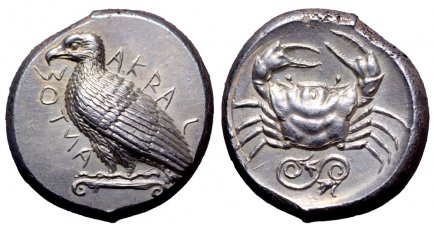 The river crab from the river Akragas became the emblem of the city.
The river crab from the river Akragas became the emblem of the city.
A 100 years or so earlier, Gela was settled by Greeks from the islands of Crete and Rhodes. By this time, Eastern locations with good harbors were already claimed so the colonists from Rhodes and Crete settled on the small curve of land on the southeast of the island. They justified their choice of location with the explanation that, according to Thucydides, this was the location where Daedalus landed after escaping his imprisonment in a tower in Crete. Daedalus escaped with his son, Icarus, with the help of wings made of feathers and wax. Icarus flew to high to the sun and, basically, his wax wings melted. Daedalus continued onto Sicily.
Although Crete and Rhodes were latecomers in the colonization of Sicily, it turned out that Gela had the best farmland of all the colonies and since wheat was the main item of trade back to Greece, in a short time, Gela became the wealthiest of all the Greek colonies.
Akragas had the same success as a farming community as Gela, and from its position perched up on a bluff, it held a vantage point against any possible invasions.
Ten years after the founding of Akragas funds were given to a man named Phalaris with the intention of building a great Temple to Zeus. Phalaris instead used the funds to buy himself an army of mercenaries who went on to seize the city and make him it Tyrant. By the way, the term Tyrant (originally Greek Tyrannos) was originally defined as someone who took power by force from a previous governing body. Not all tyrants were cruel, however, Phalaris was one of the rulers who gave the word Tyrant it’s current definition as an autocratic oppressive dictator.
The first few years under Phalaris were pretty good. Akragas was prosperous and Phalaris paid for civic improvements; new temples, city buildings and fortifications around the city. But with more wealth and more power came more corruption. Phalaris went crazy with narcissism and paranoia.
The stories of his cruelty ranged from eating young babies to devising new methods to torture his enemies.
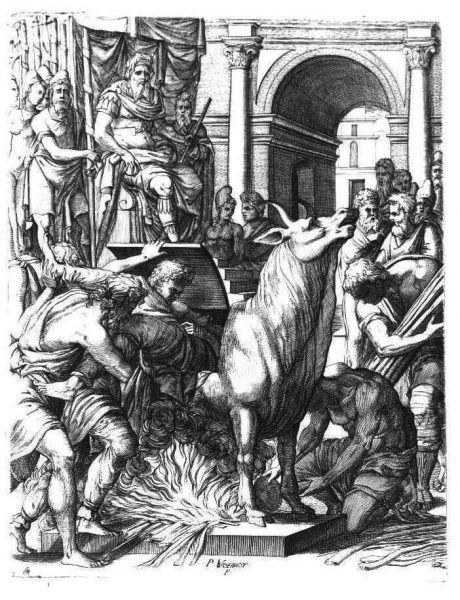
In his most infamous invention, Phalaris gave the artisan, Perillos of Athens the commission of creating a bronze bull to use for his torturous executions.
The enormous bull had a door on one side to fit the condemned person. Once inside, a fire was lit under the bull. The screams of the tortured prisoner echoed through a system of chambers so that it resembled the bellowing of an enraged bull.
Perillos thought he would be paid a lot for his creation. Instead, Phalaris threw him inside the belly of the bull and lit the fire. When he was satisfied that the screams of Perillos did in fact resemble the bellowing of a bull, he opened the door, pulled Perillos out of the bull and then threw him off a cliff in order to avoid the payment.
When Telemachus overthrew Phalaris in 554 BC, he threw the deposed Tyrant into the belly of his bull and killed him.
The bull disappeared from Akragas in 405 BC when the city was taken by the Carthaginians, who just happened to used a bronze bull to sacrifice children to their god, Baal Hammond. Supposedly, Scipio Aemilianus returned the bull to Akragas (then Agrigento) after he sacked Carthage at the end of the 3rd Punic war in 146 BC. This is the last we ever heard of the brazen bull.
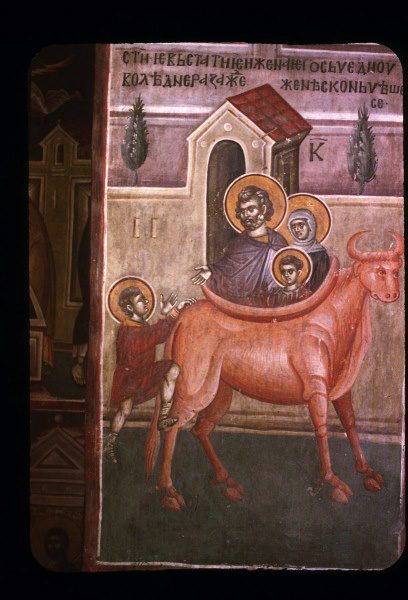 Bronze Bull executions made it to rule of the Roman Emperor Hadrian who, according to Christian lore, ordered the execution of Saint Eustace and his family by roasting alive in a bronze bull. Saint Antipas was burned alive in a brazen bull during the reign of the Emperor Domitian.
Bronze Bull executions made it to rule of the Roman Emperor Hadrian who, according to Christian lore, ordered the execution of Saint Eustace and his family by roasting alive in a bronze bull. Saint Antipas was burned alive in a brazen bull during the reign of the Emperor Domitian.
Empedocles
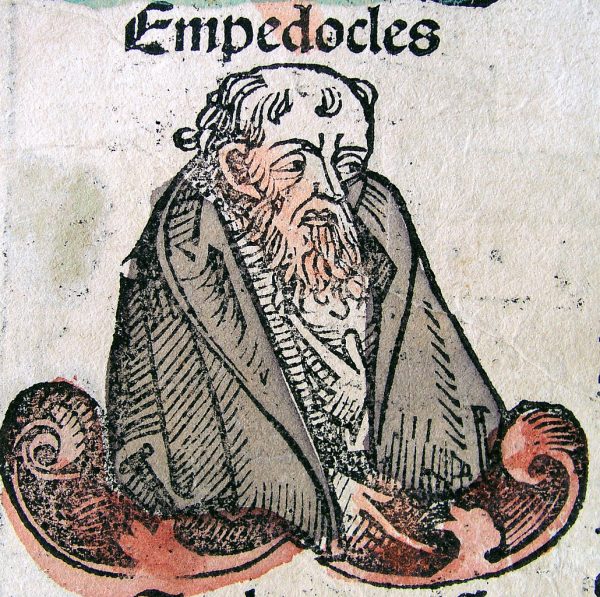 Although Phalaris might be the most sensational historic figure of ancient Akragas, the city’s most historically revered is the philosopher, Empedocles.
Although Phalaris might be the most sensational historic figure of ancient Akragas, the city’s most historically revered is the philosopher, Empedocles.
He was born around 495 BC into a wealthy and influential household and is credited with the ability to cure the sick and control the weather.
It was Empedocles who created the theory that all things were made of four elements; earth, water, fire and air. Objects would change or be altered when the elements changed their positions, which is still one of the principles of modern physics.
According to Empedocles, love held the particles together. Hate split them apart.
Empedocles believed everything to be made of these elements, including atmosphere. In 430 BC he brought a group of students to the top of Mount Etna and in order to prove that the heat vapors actually had enough substance to support his weight, he jumped into the volcano. He never came back although according to the legend, the volcano burped and threw back one of his sandals.
The Golden Age of Akragas
Although Akragas was a successful and wealthy city for many years, it was during the reign of the Tyrant Theron (488 BC – 473 BC) when most of the city we see today was built.
The defeat of the Carthaginians by Theron and his son-in-law Gelon of Gela at the 480 BC Battle of Himera gave him more than enough money to build an amazing city, 456 hectares surrounded by a 12.9 km fortress wall with 9 gates.
At the Zenith of the Akragas, the population swelled to around 2000,000 but the end pretty much came in 405 BC when, after a long 8 month siege, 120,000 Carthaginians sacked the city.
The city was rebuilt but in 262 BC, during the First Punic War, Akragas was attacked by Roman armies trying to keep the city out of the Carthaginian hands. The Romans cut off supplies to the city, trying to starve them into submission but the city held out till the Carthaginians arrived. After a hard 2 months of conflict, Rome was victorious. The Carthaginians were defeated and the entire population of Akragas was sold into slavery.
in 201 BC, at the end of the 2nd Punic War, the Romans resettled the city as Agrigento. They fortified the walls and gates, rebuilt many of the city structures and changed the names of the Temples from Greek to Roman.
In 829, the Muslims laid siege to Agrigento and changed the of the city to Gergent. When the Norman invasion of Sicily was completed in the 11th century, the city name was altered once again to Gergenti.
It remained Girgenti until 1926, when Benito Mussolini changed the name back to Agrigento.
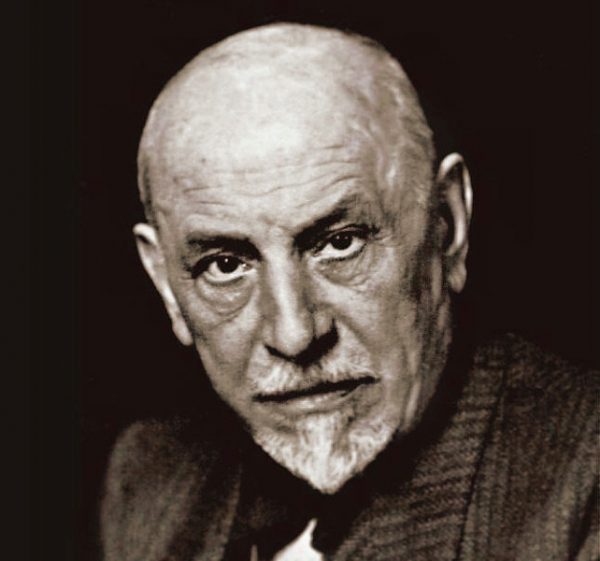 Modern Agrigento is a small town of narrow winding Medieval streets filled with a renovated old world charm.
Modern Agrigento is a small town of narrow winding Medieval streets filled with a renovated old world charm.
Girgenti (Agrigento) was also the 1867 birthplace of Luigi Pirandello, one of Italy’s greatest playwrights, and recognized by some as the father of the theater of the Absurd. In his most absurd moment he gave his 1934 Nobel Prize medal to be melted down for the Fascist invasion of Abyssinia.
Valley of the temples (Valle dei Templi)
The archeological site is the best preserved ancient Greek city in all of Sicily. Some of the Temples are referred to by their Greeks names, others by their Roman names.
The site has been restored and rebuilt for years thanks to the over 70,000 visitors each year.
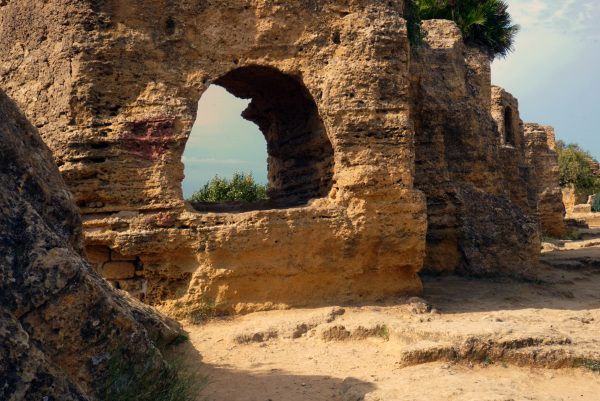
The 12.9 km fortress wall is mostly destroyed but some stretches remain. The red limestone walls were dug out after the 12th century and used as a necropolis by the Christians.
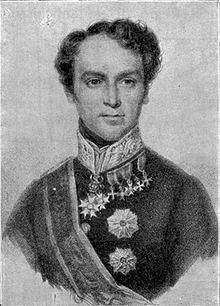
Excavations of the ancient city started in the early 19th century by a man called ‘Serradifalco’, the Sicilian born Domenico Antonio Lo Faso Pietrasanta, Duke of Serradifalco.
He was a student of architecture and history, trained at the University in Milan. He was exiled during the 19th century Bourbon rule but returned to Sicily after Garibaldi’s 1860 victory. In his position as President of the Commission of Antiquities and Fine art, Serradifalco directed the excavations of the Valley of Temples here in Agrigento as well as archeological digs in Selinus, Segesta, Syracuse and Taormina. He died in 1863 but thankfully, the excavations continued.
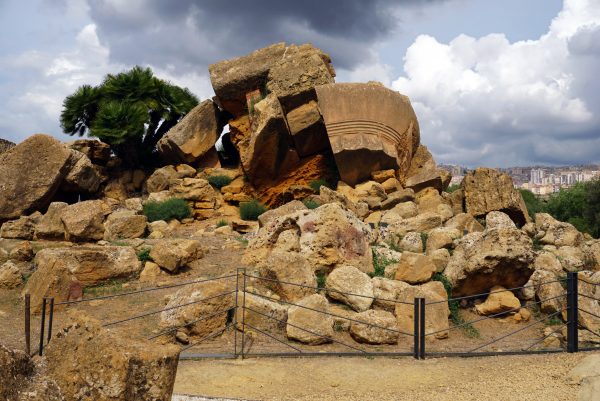
Most of the temples collapsed from centuries of earthquakes and pilfering. The Temple of Zeus ended up as a pile of rocks. Most of it was hauled away between 1749-1763 to built the jetties of nearby Porto Empedocle.
Although the ancient site is enormous, most of the restored temples are in an area easily navigated on foot within the confines of the Archeological park.
There are 2 large parking lots, one coming the from the south off the SS 115 and another at the west side of the park, on the SP 4, near the Temple of Giuno (Juno).
Temple of Juno Lacinia (Temple of Hera Lakinia)
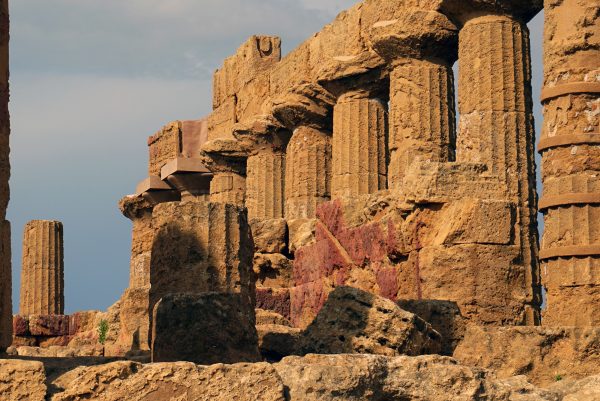
The 5th century Temple of Juno Lacinia was destroyed during the 405 BC sack of the city by the Carthaginians. There are still visible scorch marks from the fire.
Juno Lacinia is the Roman name. When it was constructed around 450 BC it was dedicated to the goddess Hera Lakinia, wife of Zeus. Zeus, Hera-Greek, Jupiter, Juno-Roman.
Most of the Greek Doric Temples of Sicily follow the same design, 6 columns at each end and 13 columns at each side. There was a pronaos (porch) at the entrance which led to the a walled off Cella or Naos surrounded by a portico of columns. The cella was the room of the God and only accessible by the priests. Worship took place outside of the eastern entrance to the Temple. Behind the cella, there was often a treasury room.
Take a look at the fallen stones and broken column pieces. You’ll see a U shaped grove at the ends of the segments. These were used for ropes to lift the pieces into place. You’ll also notice square holes used to position to the column segments.
Temple of Concordia
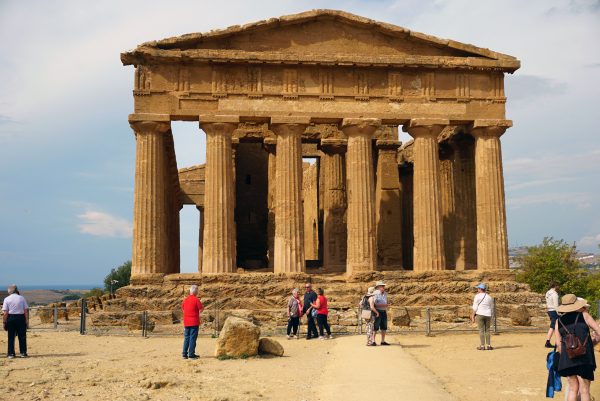
Concordia is the best preserved 5th century BC, Doric style temple in Sicily, and possibly in the world. Concordia, like all the other Temples of Akragas, was made of red limestone. To put in in perspective with other Greek temples of the time time period, Concordia has 6 columns on the facades and back and 13 columns on the sides. The more famous Parthenon in Athens, constructed at the same time, was made of limestone and marble with 8 columns on the facades and 17 on the side.
Vitruvius wrote that the doric foot was equal to 1/6th the heigh of the human body. The same principal was used in constructing Doric temples where the height of the columns is 6 times the diameter of the column base.
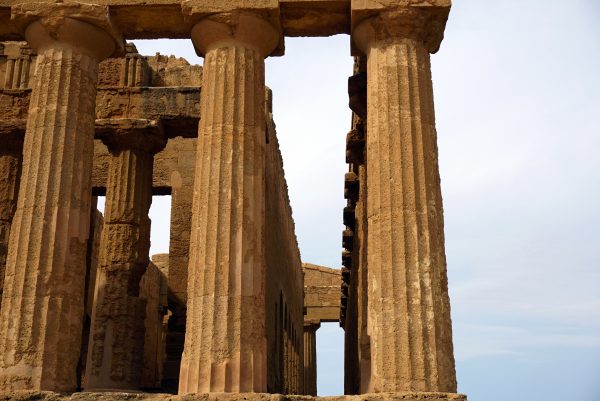
The Temple architecture also uses an architectural trick known as entasis, where the base of the column is thicker than the top. Entasis gives the optical illusion of straightness. Without the entasis, the temple would appear to bow outward.
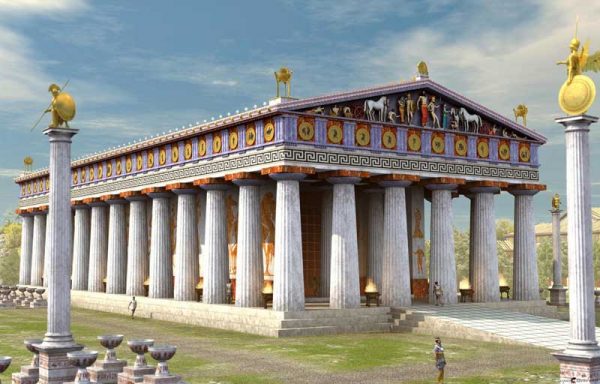
When the Temples of Akragas were first constructed the pediment, tympanum, metopes and triglyphs were all painted in bright colors.
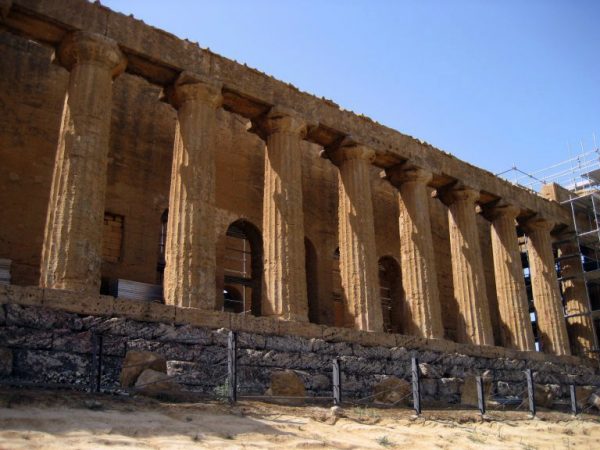
The Concordia Temple is in such great condition thanks to the Catholics, who converted the Temple into a Church 597 AD. Although they did save the Temple from destruction, they did make alterations, opening the cella walls to create access to the church. Concordia was restored to the original Temple plan in 1788.
It is interesting to note that the ancient Greeks positioned their Temples to face the east so the Temple god would greet the first light of the sun. Although Christians continued to pray to an eastern oriented altar, the main entrance to the Church was placed on the western side. When the Christians reappropriated the Greek Temples, they put the front door in the back.
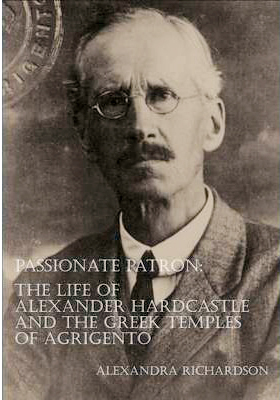 Alexander Hardcastle, an English captain in the Royal Navy, came to Agrigento (then Girgenti) in 1920. He had family wealth, funding and great hopes of finding a buried theater in the ruins of ancient Agrakas. From his villa Aurea, built next to the Temples he spent the next 12 years trying to find the theater. He never did. However, thanks to Captain Hardcastle we now have have the partially restored Temples of Hercules and Castor and Pollux.
Alexander Hardcastle, an English captain in the Royal Navy, came to Agrigento (then Girgenti) in 1920. He had family wealth, funding and great hopes of finding a buried theater in the ruins of ancient Agrakas. From his villa Aurea, built next to the Temples he spent the next 12 years trying to find the theater. He never did. However, thanks to Captain Hardcastle we now have have the partially restored Temples of Hercules and Castor and Pollux.
Hardcastle went through his entire fortune in his attempt to restore Agrakas. He died a poor man in 1933, at the age of 61. His money and health all declined at the same time. He died in 1933 and was buried in the Buonomorone cemetery on a hill overlooking the park. His villa Aurea is now used as a temporary museum. A bronze bust of Captain Hardcastle continues to welcome people to the villa and the archeological park.
Temple of Hercules
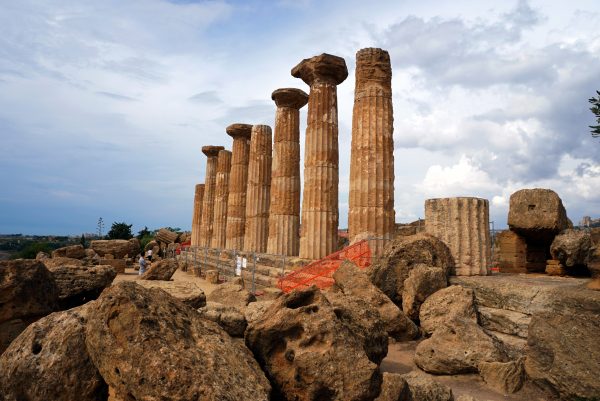
In 1921, Hardcastle restored 8 columns and the crepidoma (platform) of the Temple of Hercules. Before the restoration there was one standing column and a pile of rocks.
Temple of Castor and Pollux

He also restored the corner of the Temple of Castor and Pollux. Actually, this was the Temple of Demeter and Persephone was built between 480 BC and 460 BC. The Romans changed the name to Castor and Pollux 201 BC. The original Temple was the same size as the Temple of Concordia with 6 columns at the facades and 13 columns along the side.
Temple of Olympian Zeus
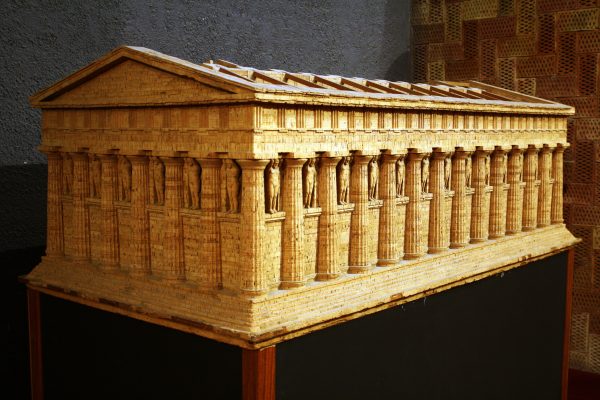
The largest temple of the Archeological Park is the Temple of Olympian Zeus, built to commemorate the 480 BC Battle of Himera that basically started the conflict between Syracuse and Carthage.It’s believed it was the largest Doric Temple ever built, although the temple was possibly never completed.
It measured 373 feet long by 185 feet wide. The base and steps were close to 20′ tall. The 56′ tall columns were then erected on top of the crepidoma platform. The fluting of each column was so wide it could conceal a human inside of the flute.
The tympanum, architrave, triglyphs and metopes of the upper Temple frame added more than another 30′ of height making the overall height of the Temple well over 100′ tall.
Although the Temple had an enclosed roof, the cella was uncovered. In our visit to the Temple in 2006, we were told if Zeus ever came down to visit, he could actually stand comfortably inside his Temple.
The sides of the Temple were supported by Telemones, 25′ tall sculpted male statues used in place of columns, although they currently look like rock creatures from a 1960s science fiction film.
In the 5th century Greece, Caryatids, female statues were used for the same purpose. The most famous Caryatids held up the porch of the Erechtheion on the Acropolis Hill of Athens. All but one of them are currently in the Acropolis museum. The other one, along with metopes and friezes from the Parthenon were taken by Lord Elgin in 1803. Greece still claims the Elgin marbles were stolen. The British Museum claims they were rescued and given to Elgin by the Turkish government who ruled Greece at the time. Greece has been trying to get it back for years and the Greek government recently secured the representation of Amal Clooney to help get them back.
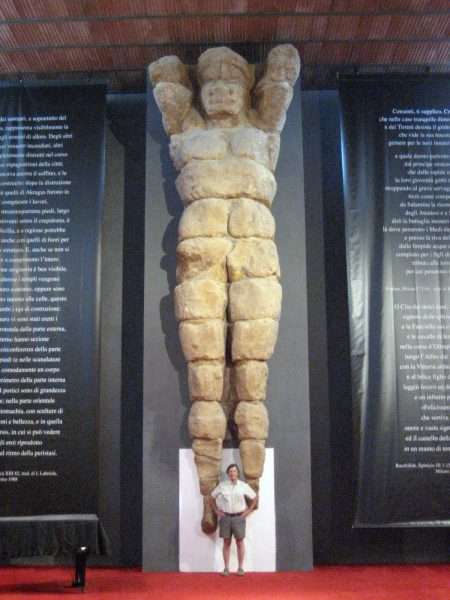
Caryatids came from Greece, Telemones came from Akragas. Both were developed at the same time, during the Golden Age of Greece in the 5th Century BC.
In the 18th century, neoclassical European architecture reintroduced the Telemone, although it became known as an Atlas or Atlantes, named after the Greek Titan who held the world on his shoulders. They are popular all over the Western world but none of them are the size of the Telemones of Akragas.
The Valley of the Temples Archeological Park is a good day’s visit. You can learn a lot from tour books, blogs and videos but I recommend a guide. My favorite is Professor Michele Gallo. Professor Gallo is from Agrigento and teaches locally. He loves the site and its history ranging from the 6th century BC through the World War II allied invasion of Sicily. You can contact Professor Michele at mgallo@sicilytravel.net
The Archeological park offers more than just the Temples. Most of the sites on the well heeled tourist hikes are listed above but the ancient city covers an enormous area. It could easily take a few days to see everything.
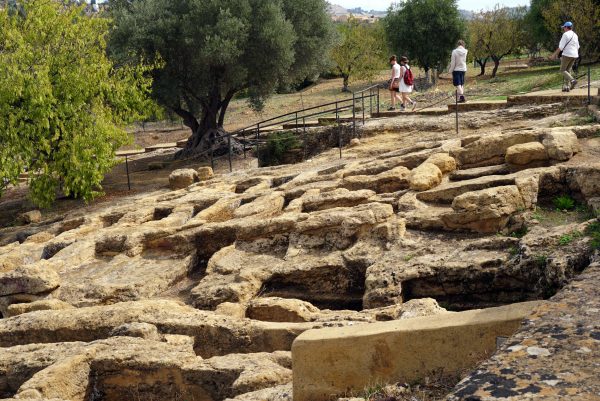
There are 1000 year old olive trees and the necropoli (burial tombs) built into the red limestone fortification walls and along the hillsides.
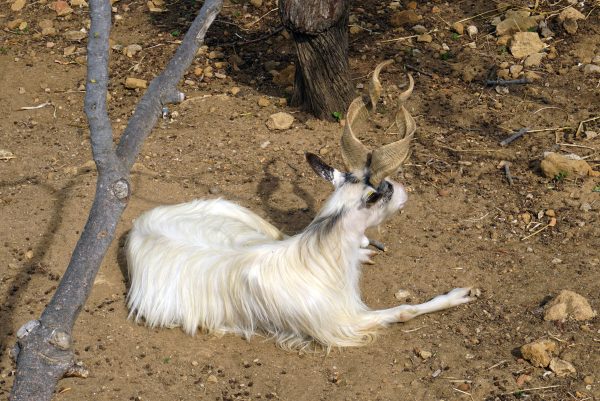
There are Girgentana goats, an endangered breed native to Agrigento. It is believed they were brought to the area by the Arabs in the 9th century. The are characterized with white coats and long twisted horns.
I highly suggest a visit to the Archeological Museum ‘Pietro Griffo’, one of the most important museums of 5th century Greek architecture. Don’t miss the treasury Room. This 1960’s museum, built around the old Cloisters of the the 12th century Church of Saint Nicholas gives you a really good explanation of the site from the Mycenaean times in the 2nd millennium BC to the Roman times of the 2nd century BC. All the rooms are in Italian and English. I suggest to visit the park first and finish with a tour of the museum. the museum is actually outside the park but when you buy your ticket to the park, buy the ticket to include the Museum.
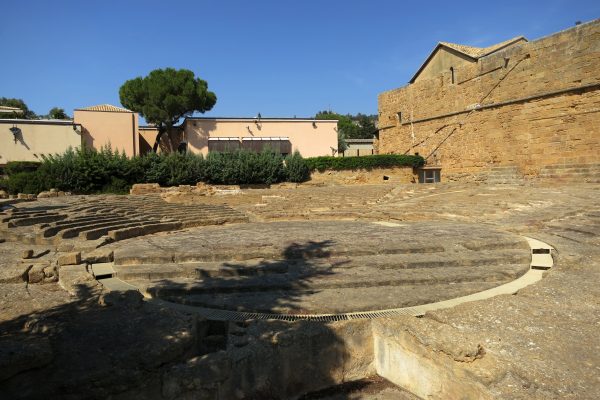
As you walk to the entrance of the museum, you’ll pass the Ekklesiasterion, a 4th century BC Odeon where citizens would listen to orators pose pro and con points of view on affairs of State. After the orations, the some 3,000 citizens would vote on the measure.
Further afield is the Temple of Vulcan (Hefestos) behind the temple of Castor and Polux. The ruins of the Temple of Asklepius, the ancient hospital are to the south of the park, near the SS115.
One last note on the Valley of the Temples. In the valley below the Temples is Roman Tomb commemorating the 3,000 soldiers who lost their lives during the 262 BC siege of Akragas. The top was once finished with a tall pyramid crown.
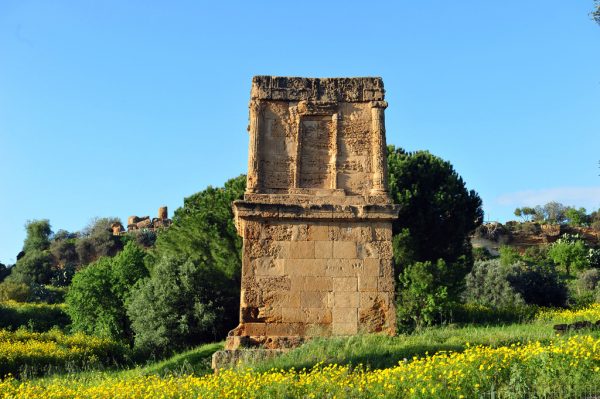 For many years, it has been referred to as The tomb of Theron, the tyrant of Akragas in the 5th century BC. It’s not, however, it is very old and worth a visit. It’s close to the parking lot at the south end of the Park.
For many years, it has been referred to as The tomb of Theron, the tyrant of Akragas in the 5th century BC. It’s not, however, it is very old and worth a visit. It’s close to the parking lot at the south end of the Park.
To read more about the Greeks of Sicily, check out my posts on:
You must be logged in to post a comment.